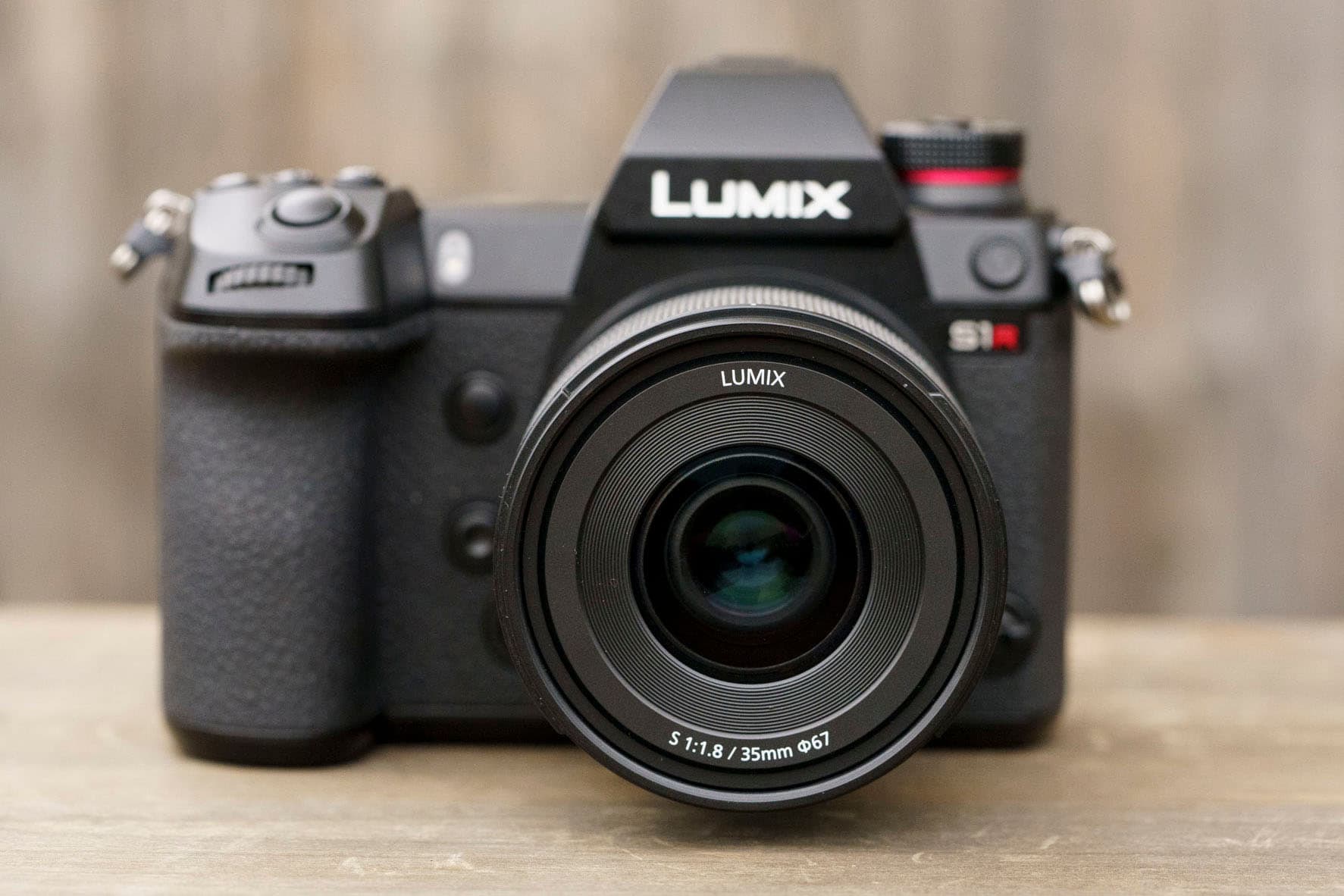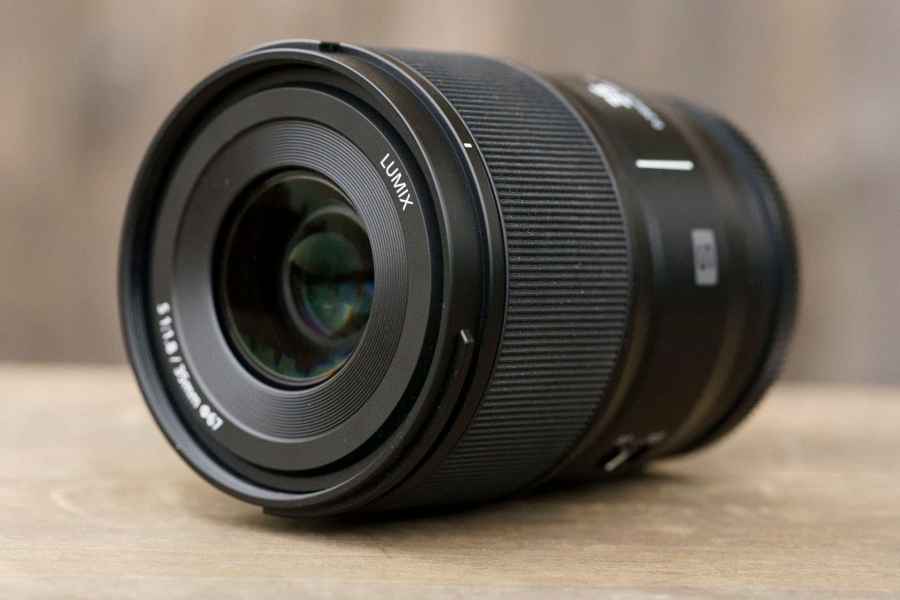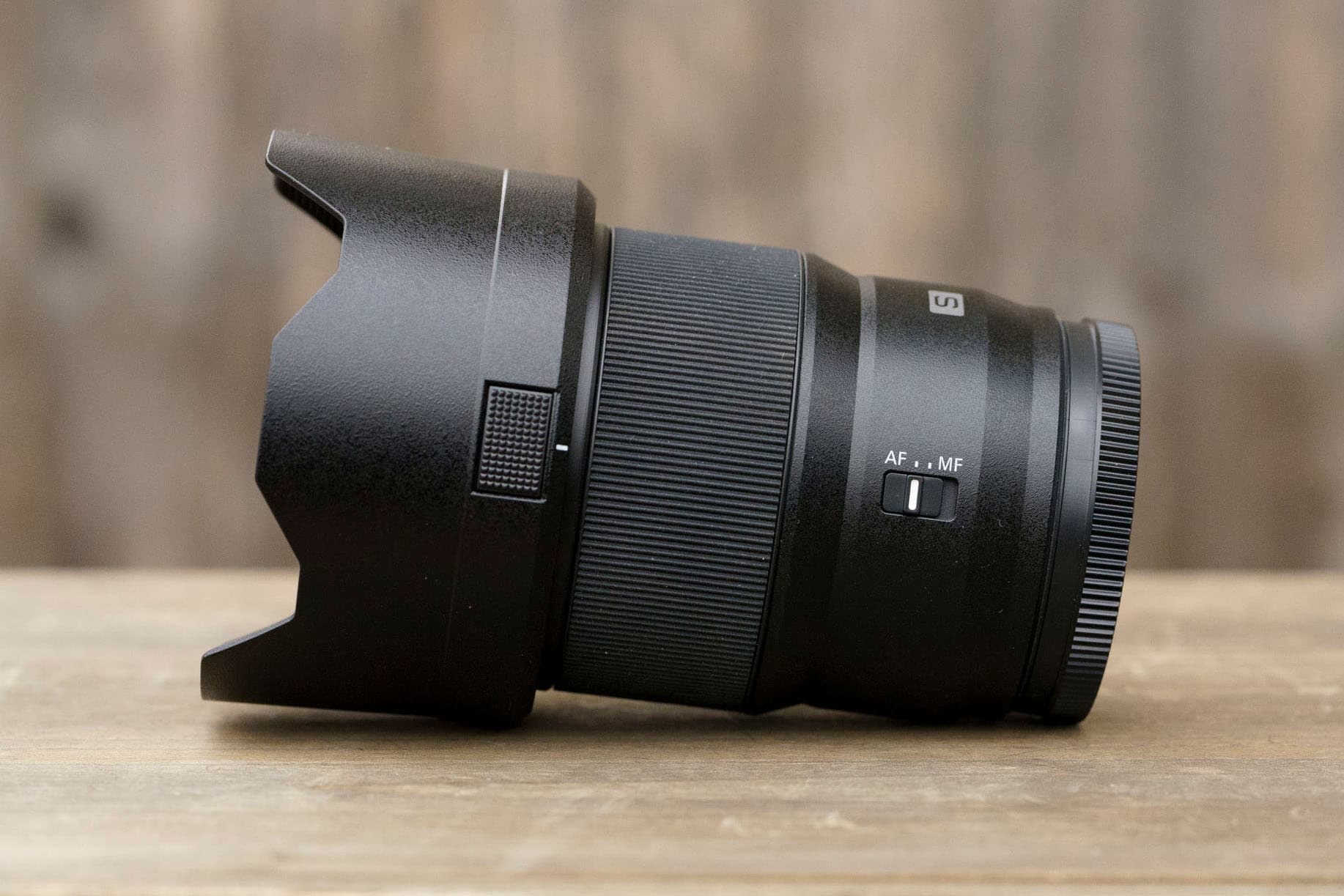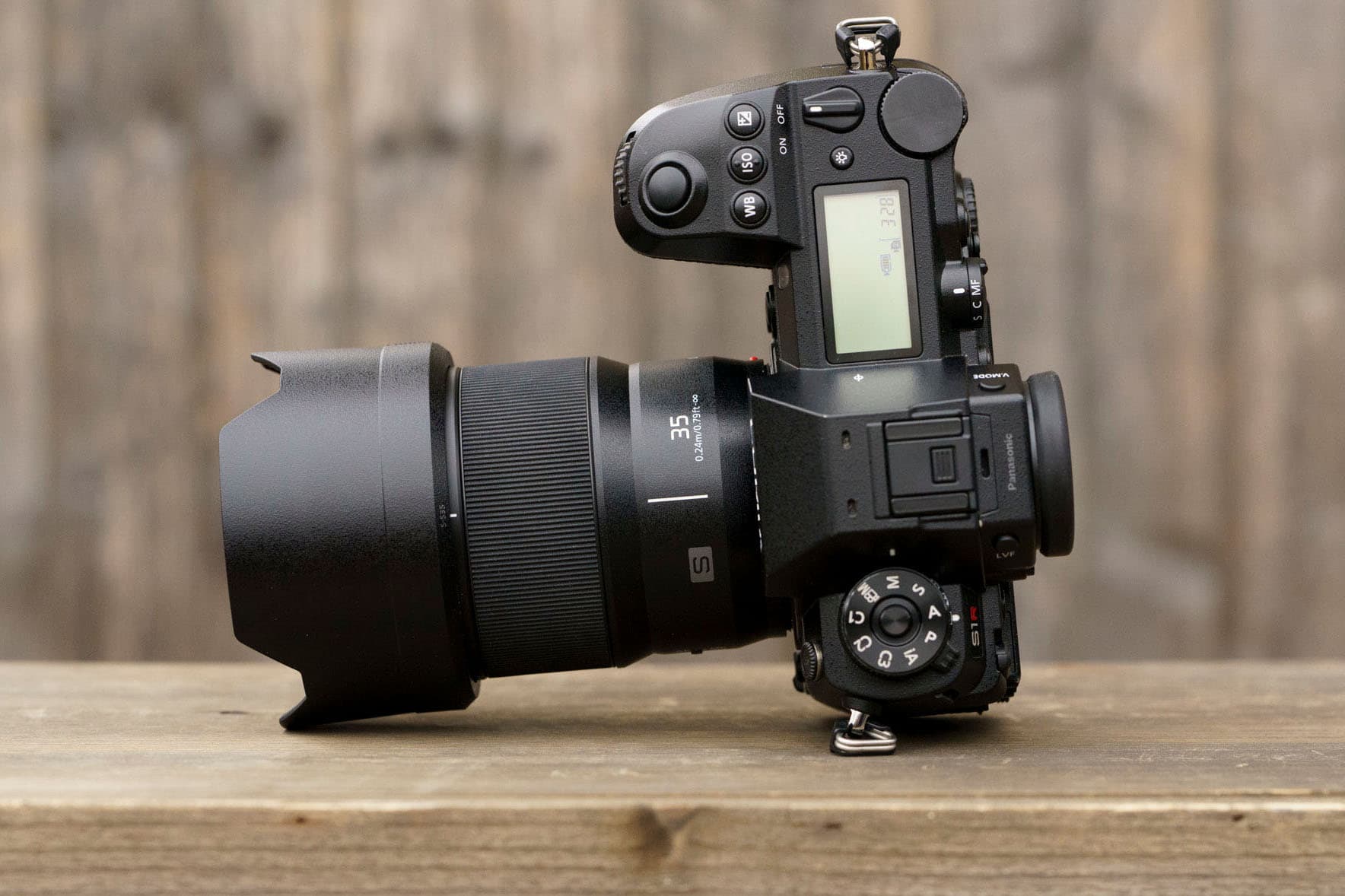Although Panasonic has four zoom lenses that cover the focal length, the Lumix S 35mm F1.8 is the company’s first 35mm prime lens for its L-mount full-frame cameras. It’s possible that Panasonic was initially happy to leave Leica to cover the focal length with the 35mm f/2 APO-Summicron-SL Asph, but as its costs £3,900, there must be many L-mount photographers who are pleased to see the Lumix S 35mm F1.8 arrive at £579. Read on to see how it shapes up.

Panasonic Lumix S 35mm F1.8 on the Panasonic Lumix S1R
Panasonic Lumix S 35mm F1.8 Features
Panasonic has used 11 elements arranged in 9 groups to create the Lumix S 35mm F1.8. Of these elements, 3 are aspherical and 3 are ED (extra-low dispersion) optics. Using aspherical elements enables the lens to be made smaller and lighter than normal optics would enable as fewer elements are required to deliver the required image quality. Meanwhile, the ED elements are designed to minimise chromatic aberrations.
Panasonic hasn’t included an optical stabilisation group in the lens’s construction, but that’s not really a drama given that it’s a moderately wide-angle optic and the company’s L-mount cameras all have in-body stabilisation.
A linear motor takes care of the autofocusing, which is designed to be swift and silent. In manual focus mode, the focus ring can operate in a linear or non-linear fashion and it’s just a case of selecting the option you want via the camera’s menu. In linear mode, the position of the focus ring determines the focus point, while in non-linear mode, the speed of the rotation comes into play which means you can make large adjustments by rotating the ring quickly. Slow movements result in subtle shifts in the focus.
Panasonic Lumix S 35mm F1.8 Build and handling
This is Panasonic’s fourth f/1.8 L-mount prime lens and it joins the Lumix S 24mm F1.8, 50mm F1.8 and 85mm F1.8 in having a fairly traditional and uncluttered appearance. There are none of the extra buttons, rings or small screens that are found on some of the fancier optics from Canon, Nikon and Sony. However, the new lens feels well-built and is weatherproof with seals around its moving parts as well as the mount.
The broad focusing ring is at the far end of the barrel, but because the lens is only 82mm long, it’s easy to reach it with the index finger and thumb of your left hand while you support the camera on the heel of your thumb. As usual with Panasonic’s f/1.8 full-frame prime lenses, the ring moves smoothly and requires just the right amount of effort, it doesn’t feel too stiff or too loose.
Each of Panasonic’s four f/1.8 prime lenses have the same design and a similar weight to make it easy to switch between them. It means that whichever lens you mount, your hands go to the same location for the focus ring and the AF/MF switch. The similar weight also means that videographers using a motorised gimbal won’t have to spend long re-balancing their camera every time they change the lens. As a consequence, they’re more likely to swap optics rather than walk around or ‘make do’ with what they have mounted.
Although there’s an AF/MF switch on the lens barrel, Panasonic S-series cameras also have a switch to set the focus mode with single and continuous AF mode being available in addition to manual. When the lens is in manual focus mode and the focus ring is rotated, a focus distance scale appears promptly in the viewfinder or on the main screen on the back of the camera. There’s also an ‘MF Assist’ option in the camera’s menu that, when activated, enlarges the area under the selected AF point as soon as the ring is rotated. This enlargement can be set to fill the whole screen or show as a picture-in-picture (PIP) display. I prefer the picture-in-picture option, as it allows me to keep an eye on the composition while focusing.
Activating ‘AF + MF’ in the camera’s menu allows the manual focus ring to be used to adjust the focus in autofocus mode. When this is in operation, the focusing distance scale and magnified area pop up as soon as the focus ring moves. It’s helpful if you need to adjust the focus, but it’s something you need to be aware of at other times to avoid the distraction of the enlarged image every time you nudge the lens’ ring.
Whether the manual focusing system is set to linear or non-linear, there are no discernible endpoints to the rotation of the lens’ ring. But in the linear mode, you can set the size of the rotation required to adjust from the closest focusing point (24cm) to infinity to between 90° and 360° in 30° steps (or to maximum) via the camera’s menu.
Autofocus
While there are faster focusing systems than Panasonic’s, I found the Lumix S 35mm F1.8 gets the subject sharp quickly in most situations. As is often the case, however, it starts to slow down and hunt a bit when the subject is near to its closest focusing distance. This is when the ability to adjust the focus manually comes in handy, but it would be nice to have a focus limiter switch as well. Keen videographers will be pleased to learn that the focusing is silent (or at least so quiet that I can’t hear it in operation), and there’s no noticeable focus breathing.
Panasonic Lumix S 35mm F1.8 Image quality
Mounted on the 47MP Panasonic Lumix S1R, the 35mm f/1.8 captures plenty of detail with good sharpness. At the widest apertures, there’s some fall off in sharpness in the corners of the image, but it’s well within acceptable limits and it’s not troublesome in real-world photography. Nevertheless, if you want to get the sharpest results across the frame, close down to f/5.6 and don’t go smaller than f/11 to avoid diffraction softening.
There’s some vignetting visible at f/1.8, which can be reduced but not eradicated by activating the in-camera Vignette Compensation. But either way, it’s negligible by f/2.8. Whether it’s the lens itself or the impact of the correction profile that’s automatically applied to the images is hard to say, but curvilinear distortion is not an issue and you can photograph subjects with straight lines without concern.
Chromatic aberration is also controlled well but I found a few mild examples while checking images at 100% on a computer screen. They are pretty subtle and I was able to eliminate them in a matter of seconds using the Defringe tool in Adobe Camera Raw.
Predictably, if the sun is in the image, you may see some flare, but it’s controlled well. In most other instances, the deep petal-shaped hood that’s supplied with the lens ensures that it’s not an issue.
Generally, the S 35mm F1.8 handles out of focus areas pleasantly, but the edges of highlights sometimes look a little harsh and a few have chromatic aberrations. They’re a circular shape at the centre of the frame but they squash into rugby balls towards the corners.
Panasonic Lumix S 35mm F1.8 Verdict
Panasonic now has four compact but not tiny, lightweight, well-made and weatherproof f/1.8 prime lenses for its L-mount cameras. At £799, the S 24mm F1.8 is the most expensive, with the others coming at £200 or more less. They make a nice collection of optics for £2,406 in total, and a faster alternative to the S 24-105mm F4 Macro OIS (£1,299.99) or S Pro 24-70mm F2.8 (£2,149). But of course, you don’t have to buy them all, you can cherry-pick your preferred focal length(s).
The new S 35mm F1.8 would come in high on my list of priorities as it makes a great choice for street and documentary photography as well as environmental portraiture and landscapes. It’s a great ‘everyday’ lens for general photography. I’d also have no qualms about shooting at any of its available apertures as it captures a good level of sharp detail and its optical flaws are controlled well throughout. But the best results are captured in the range of f/2.8-f/11.
As it’s a relatively compact lens, the S 35mm F1.8 feels good on Panasonic’s S1 and S1R, but it’s also a nice match for the smaller S5. Plus, it’s less than half the weight of either of the zoom lenses I mentioned earlier, making it a more attractive proposition to mount on the camera and carry all day on a strap over your shoulder.



















